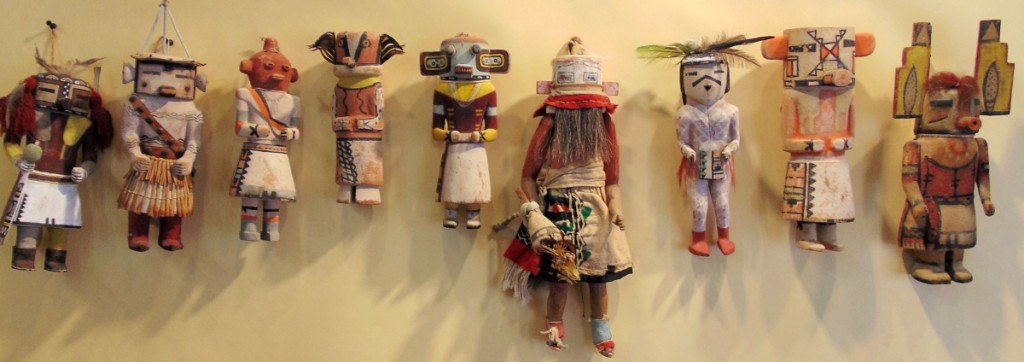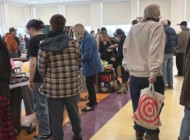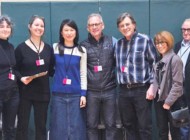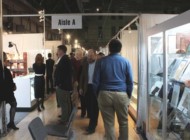Review and Photos by Walt Borton
SANTA FE, N.M. – A visit to the Antique American Indian Art Show should be added to the agenda of the thousands who flock to Santa Fe’s venerable Indian Market, now in its 98th year.
The Morris-Martindale production in El Museo Cultural took place August 14-16, on the three days preceding Indian Market, providing a perfect short course in the aesthetic and cultural heritage that informs thousands of works by hundreds of Native American artists of Indian Market in Santa Fe’s Plaza and side streets the following two days.
Save a handful of Santa Fe Galleries that hew to their Canyon Road shops, this show, in just its sixth year, increasingly attracts the finest galleries and dealers of American Indian Art, not just in the West, but in the United States. It is a cadre of exhibitors and caliber of material known and respected by America’s leading collectors and museum curators, and co-producers Kim Martindale and John Morris provide a setting worthy of both.
Space is lavished on important objects making their contemplation a sheer delight. Ted Trotta and Anna Bono of Trotto-Bono, Ltd., based in Shrub Oak, N.Y., but known on show floors in Paris, London, Brussels and New York City, presented only a handful of objects, each worthy of exploration. To this eye, the object most worthy was a pre-first contact, soapstone carving of an Adena-Hopewell Culture man, discovered near the Canadian border in New York State. If it required a name, “Dignity” would be fitting.
Traveling a few steps from pre-history to just-yesterday, a Roxanne Swentzell ceramic rendering of Ram Man rested on a George Nakashima table in the Four Winds Gallery booth.
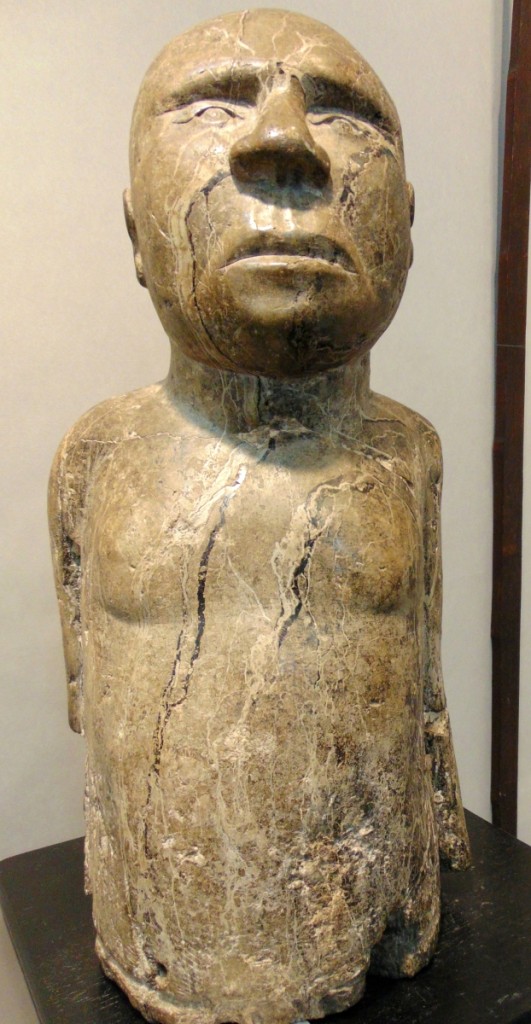
Pre-Contact post effigy, Adena-Hopewell culture, Theresa, (Jefferson County), N.Y., metamorphic soapstone, offered by Trotta-Bono, Ltd, Scrub Oak, N.Y., for $240,000.
Just beyond that, commanding its own corner in Brant Mackley Gallery’s booth, was a carved Northwest Coast grandfather clock from the Pocono Mountain mansion of Gifford Pinchot, first United States Forest Service chief. Mackley, who moved his gallery from that part of the world to Santa Fe a few years ago, said he once sold a settee from the same suite of furniture.
The Antique American Indian Art Show is a place best suited for meandering and, as they say, to let the eye feast on the beauty with which it surprises; for example, the pair of 4-foot-tall Francis Livingston oils of Katsina dolls in Mark Sublette’s Medicine Man Gallery booth. It turns out, they are part of a triptych, but the third was hiding on another wall.
Just up the aisle from Medicine Man Gallery is a space filled with brightly colored baskets by contemporary weavers of the Wounaan and Embera people of the Panamanian rainforests. For Michael Smith of Santa Fe, these baskets are not just about trade, but illustrate his gallery’s work to support those people’s relentless campaign to preserve their rainforests.
A bit further on, a piece of beadwork captures both Blackfoot beading prowess and sense of humor. As the Blackfoot people dealt with the arrival of white men in starched collars and ties, they wryly commented on that look by creating a unified collar and tie resplendent with beaded patterns. An example in outstanding condition was shown at AE Tribal Antiques, Laguna Niguel, Calif.
A display of elaborately decorated and thoroughly documented Native American horse bridles was shown at Hawk Hill Press, Nicasio, Calif., accompanied by seven illustrated large format books on Western ephemera, three of them on bridles alone. They are the work of Ned and Judy Martin, who have also published on contemporary spurs, spurs in the Texas style, in the Vaquero style and Indian horse masks.
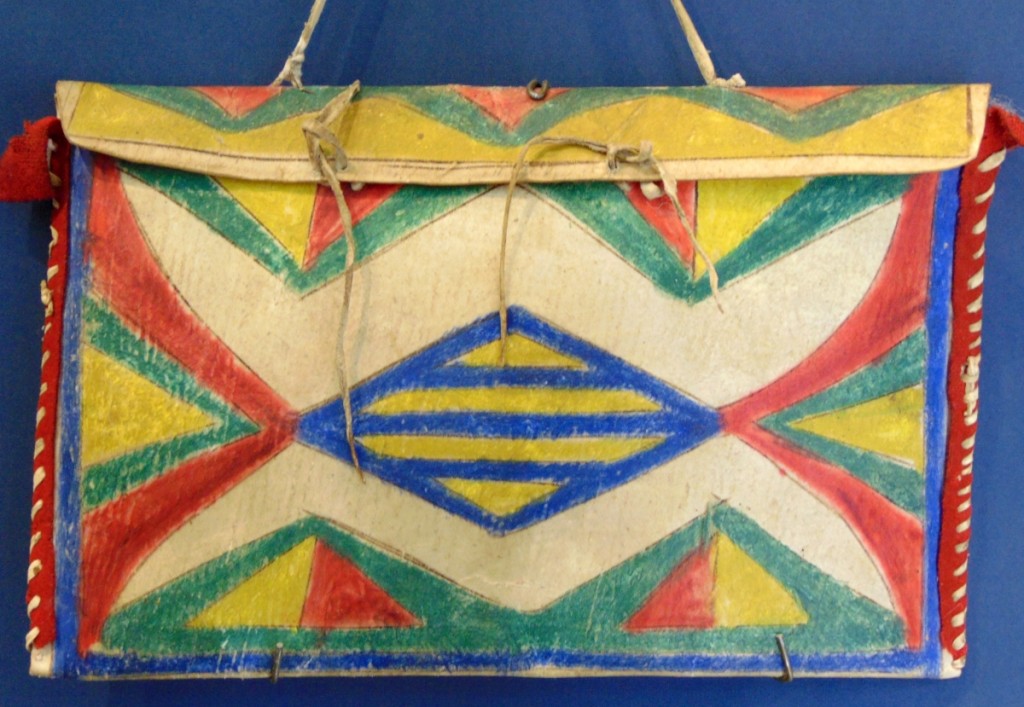
A late Nineteenth Century Lakota painted parfleche dispatch case, offered by John Molloy Gallery, New York City, at $1,800.
There were dozens of notable baskets in Terry Dewald’s booth, from tiny Tahono O’Odham horsehair baskets, to spectacular Pimas. But it didn’t take long for word to flash across the show floor that Dewald had what folks were soon referring to as “the million-dollar basket.” Woven on commission for Indian Field Days in the Yosemite Valley by Terry Bethel, a Mono Lake Paiute, the basket was completed in 1958. “The huge values on baskets,” Dewald said, “usually center on Dat So La Lee baskets. She was a weaver from the Lake Tahoe area with a promoter and the last couple of her baskets sold for well over a million dollars. One of them was donated to the Met. But this basket here absolutely surpasses hers.” DeWald, among the top basket experts in the world, said that a basket in the Philbrook Museum in Tulsa, Okla. is said to be the best and he has appraised it at well over $1.5 million. “This basket is far superior,” he said.
Commanding beauty comes in many forms as evidenced by the mid-Nineteenth Century Orca wood carving in Mark Blackburn’s booth. Completed not long before Northwest Coast woodcarving was banned in a futile, nearly century-long government effort to stamp out Native spirituality, this totem pole top is a powerful illustration of why such a ban would never succeed. Blackburn, from Honolulu, values the piece at $12,000.
Despite the ban on the custom of potlatch and with it the carving of objects to give as gifts, carving quietly endured on the Northwest Coast, as evidenced by a late Nineteenth Century argillite stone carving of a canoe carrying representations of the Haida legends in the Pook A Moon booth.
Business was unusually good at this show, especially in a segment of the art market that has, in recent years, suffered from political issues around ownership of material, cultural appropriation and the commodification of spiritual objects. Still, there is much more to the event than its marketplace. To walk through the Antique American Indian Show is to encounter the history, the tools, the weapons and the spirituality of America’s first peoples.
That was most pronounced in Paul Unks’ show-sponsored lecture on the photography of Edward Curtis, on Friday, August 16. Since 1995, when Unks discovered a near-perfect set of Edward Curtis’s 20-volume work, The North American Indian, in the climate-controlled archives of the University of Denver, Unks’ life’s work has been assuring the future of those images.
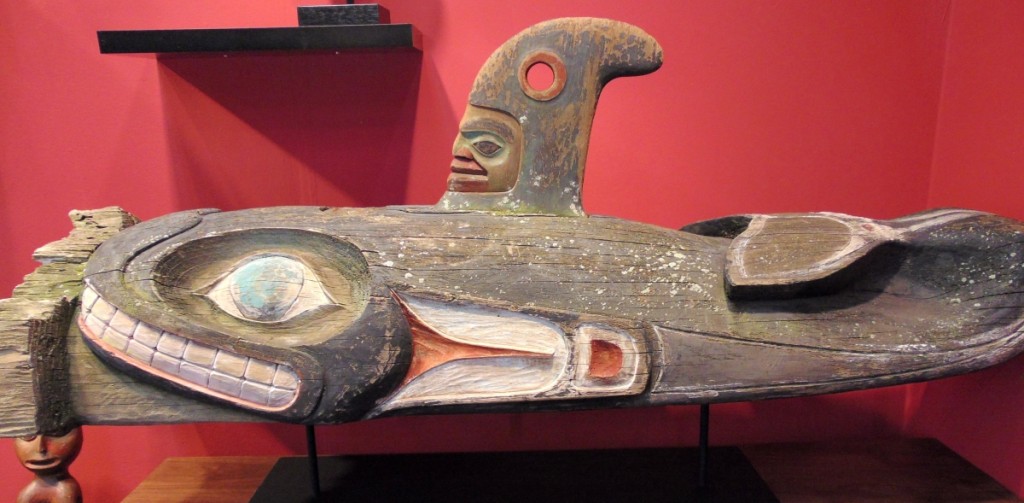
Northwest Coast wood-carved top of a 20-foot totem pole, probably Haida, mid Nineteenth Century offered by Mark Blackburn, Honolulu, for $12,000.
By then, Curtis’s original copper plates for the photogravure edition had deteriorated beyond recovery in a damp Boston cellar. Unks set about using the Denver edition to painstakingly create new copper plates and to hand-process new photogravures of the original Curtis work, including his Mountain Hawk Fine Art marque so they are not confused with the originals. He has since enhanced existing Curtis images with gold tone and platinum tone process and larger print sizes to reveal more of Curtis’s photographic detail and sells prints from each process.
Unks’ lecture, however, was more about Curtis the cultural historian and philosopher, than the photographer. In it, Unks compellingly portrayed Curtis as a conscious witness to the passing of a civilization, passionately devoted to capturing its images before its last light. He also revealed his own mission: to ensure that Curtis’ images not only endure but, for the descendants of those in the images, to preserve strands of that civilization to weave into their futures.
The Antique Indian Arts Show seemed a most appropriate place for that vision.
For additional information, www.antiqueindianartshow.com.

